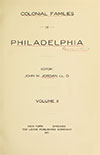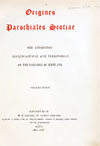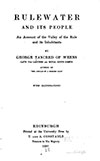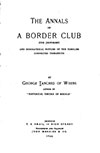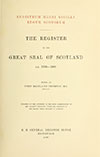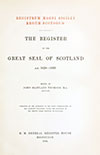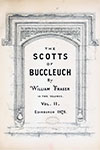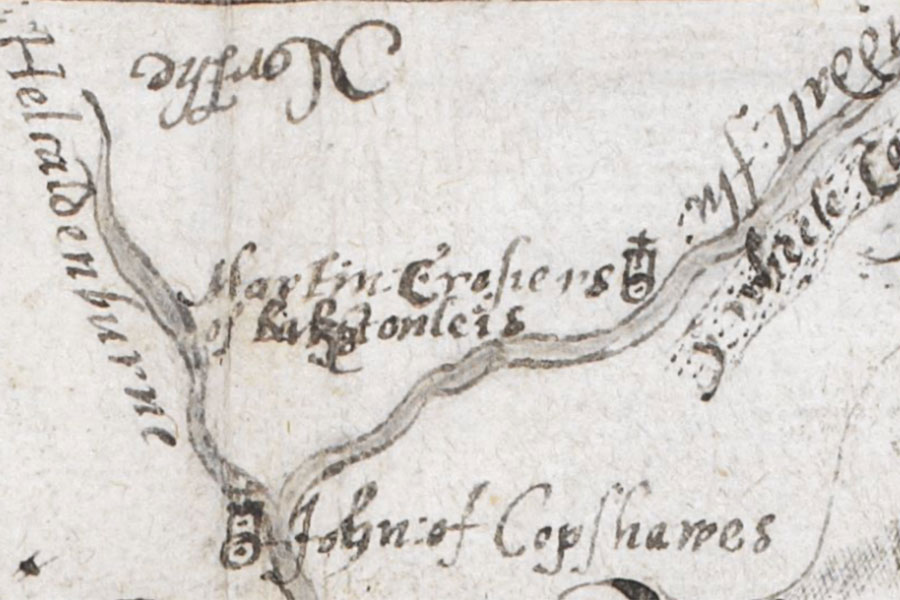

There was a tower at Peel named Baxtonlees, sometimes erroneously referred to as Rakestonleis, in the 16th century but nothing of it now remains.
In the 14th century, and possibly earlier, the lands of Baxtounlyis, along with the lands of Chishope (or Cleishope), Over and Nether Wheelkirk, Wheelland, Ormescleuche, Abbotsyke and Abbottshawes, were part of the lordship of Liddesdale that was owned by Jedburgh Abbey. Collectively they were valued at ten marks, or £6 13s. 4d at the old extent.
Little seems to be known about the tower besides the name of its owner towards the end of the 16th century, Martin Crosier or Crozier. The tower is labelled with the caption “Martin Crosiers of Bakstonleis” on a map of 1590 which appeared in “An atlas of England and Wales, made by Christopher Saxton”, a book owned by William Cecil, 1st Baron Burghley, and commonly referred to as The Burghley Atlas.
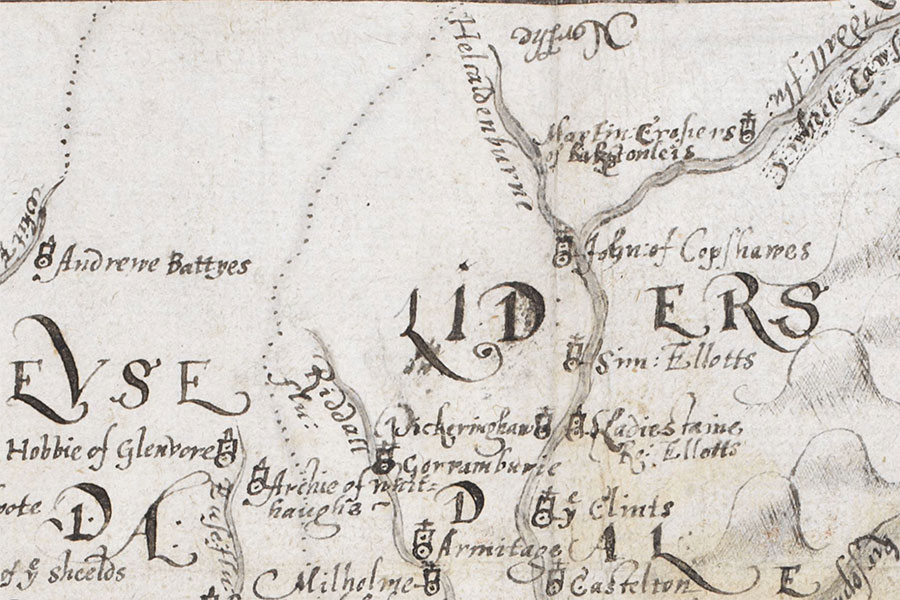
The tower was of strategic importance, standing on the opposite bank to the Wheel Causeway, a major medieval road from Roxburgh to Annandale.
Crosier was a prominent member of his clan, and a notorious Border reiver. He may be the Martin Crosar who was a tenant, along with Patrick Crosar, Rolland Elwald or Elliot, and William Elwald, at Ricardtoun in 1541. A Martin Crozier or Martyn Crossers is listed as residing at Yarsaye or Earlside in 1544, and in 1547 the lands of Thornebogg belonging to Martin Crozier in the Slitrig valley were burned by English.
“Martine Crossar in Beddroule” promised to refrain from theft in 1576, when Sir Thomas Turnbull of Bedrule provided surety for him, however two years later he was declared a rebel.
In May 1582 three Englishmen, Mathewe Wilkinsone, Robert Snawedon and George Stevensone, “were going to the Slyme together” (probably the notorious Slyme alehouse at the head of the Coquet in Northumberland, when they encountered an unknown man “in an old graye cloke” thought to be “a Jesuite or suche like”. He refused to give them his name but said he was on his way to Martyne Croser’s.
Where exactly Martyn Croser’s was is not stated but it’s conceivable that the stranger was taking a route through the Cheviots to Baxtonlees. The three men detained the traveller and said they would take him to Sir John Forster, Warden of the Middle Marches, but he offered them 11 pieces of gold to let him escape. Instead they took his gold, a bag, an old breviary, “certen instrumentes to drawe forth teethe”, and a “lookinge glasse” which was later found to contain hidden letters written in code, and after walking with him for half a mile let him go.
They detained him and said they would take him to the Lord Warden (Sir John Forster, Warden of the Middle Marches) but he offered them 11 pieces of gold to let him escape. Instead they took his gold, a bag, an old breviary, “certen instrumentes to drawe forth teethe”, and a “lookinge glasse” which was later found to contain hidden letters written in code, and after walking with him for half a mile let him go.
In the late 1580s Martin Crosier was the subject of numerous complaints to the English Warden of the Middle Marches for cross-border raids, alongside many other prominent Border reiver families. An Act of Parliament was passed in Scotland in July 1587 to try and control the unruly Border families and for “the quieting and keping in obedience of the disorderit subjectis, inhabitantis of the bordouris, hielandis and ilis”. Several clans were named, including for the “Middle Marche” the Ellottis, Armestrangis, Niksonis and Crosaris.
Martine Croser was described as “late of Baxtoun lee” in a June 1590 bill of complaint regarding a raid carried out in November 1589, perhaps suggesting that he had died in the meantime. If so then it’s possible that he had a son of the same name as Martin Crosier continues to be named in complaints.
Six bills of complaint were filed against Liddesdale by the English over the reivers’ activities in the Middle Marche prompting James VI to meet with his Borders lords Francis Stewart, 5th Earl Bothwell and Keeper of Liddesdale, John Maxwell, 8th Lord Maxwell, Alexander Home, 6th Lord Home and Warden of the East March, and John Carmichael of Carmichael in January 1590. Bothwell promised to summon “his men filed in said bills”, amongst whom was Martyn Croser of Blackstaneley.
Martin Croser was included in Monipenny’s List of the Border Clans in 1597 as one of the “Chiefe Men of Name” of “the prinicipall Clannes and Surnames of the Borders”.
By 1605 the lands of Baxtonlees seem to have passed out of Crosier ownership as in July of that year James VI dismissed the fee-farm and quitclaim on the lands of “Baxtanleis, Over et Nether Cleifhoippis, Quheilkirk, Quheillandis, Ormescleuch, Abbottesyikis, Abbotischairis, Belschis in Liddisdaill”, and others for Master John Prestoun, junior, son of Sir John Prestoun of Fentonbarns and Penicuik. Prestoun’s father was Baron of the Exchequer and President of the College of Justice.
However in March 1606 James VI granted numerous lands which once belonged to Jedburgh Abbey, including “Baxtounleyis, Cleiffhopott Over et Nethir, Queilkirk, Quheitland (vel Quheillandis), Ormescleuche, Abbotsykis et Abbotschawis”, to Alexander Home, 1st Earl of Home and Lord of Jedburgh and Dunglas. Home’s tutor growing up was Andrew Home, the last commendator of Jedburgh Abbey.
In June of the same year Master John Home, legitimate son of the late John Home of Carrelsyid, signed a contract selling the lands of Baxtaneleyis to Gilbert Ellott of Horsliehill. The Homes of Carolside were related to the Earls of Home but I haven’t been able to find the exact connection.
I suspect that the Earls of Home must have retained the superiority of the lands of Baxonlees as the 1st Earl of Home received a new grant of the former lands of Jedburgh Abbey, including Baxtounleyis, Cleiffhoippis Over et Nether, Quheilkirk, Quheilland, Ormescleuch, Abbatesyike, Abbatschawis”, in May 1610.
In June 1611 the 1st Earl of Home signed a contract of compensation with Lord John Ker of Jedburgh and resigned the lands of “Baxtounleyis, Clefhoippis Ovir et Nethir, Qu(h)eilkirk, Quheilland, Ormescleuch, Abbottisyk et Abbotischawis”. Lord Ker received a new grant of the same lands as part of the lordship and barony of Jedburgh in April 1619 following the death of the Earl of Home earlier that month.
Walter Scott, 1st Earl of Buccleuch and Lord of Quhitchister and Eskdaill, was granted the lands of “Baxtounleyis, Cleifhoipes Over et Nether, Quheilkirk, Quehilland, Ormescleuch, Abbotsyk et Abbotschawis” in March 1621, which Lord John Ker of Jedburgh and his son, Lord John Ker of Langnewtoun, had resigned.
Jedburgh Abbey’s former lands seem to have been granted regularly by the King to different individuals, as in July 1623 they were granted to Thomas Hamilton, 1st Earl of Melrose, Lord President of the Court of Session, before they were granted to James Home, 2nd Earl of Home, in February 1624, then in April 1624 the lands were again granted to the 1st Earl of Melrose.
The tower is marked on Blaeu’s map of Liddesdale as Baikstontyes, most likely a transcription error from an earlier map for Baikstonlyes.

Against the backdrop of changing ownership the Elliots seem to have retained their interest in Baxtonlees as in 1657 Sir Gilbert Elliot of Stobs, eldest son of William Elliot of Stobs, succeeded to his father’s lands, including Baxtonlees. Sir Gilbert was a grandson of Gilbert Ellott of Horsliehill who bought the lands of Baxtaneleyis in 1606. Two years later Sir Gilbert sold Baxtonlees to William Elliot of Binks and Swynside and his third son, John, in fee.
The lands of Baxtonelies were included, along with numerous others, in a contract of marriage between James, 1st Duke of Monmouth and eldest illegitimate son of Charles II, and Anne Scott, 1st Duchess of Buccleuch and granddaughter of the 1st Earl of Buccleuch, in April 1663. This would again appear to refer to the superiority of the lands as the lands seem to have been held by the Elliots throughout this period. In a 1681 account of the King’s rents the “landes of Baxtounleyes, Cleisthope, Over & Nether Whytkirk, Allilland, Ormeistcluch, Abbotsyde, & Abbotishawes” were valued at “the soume of 155lb. 3s. 4d.”
Early in the 18th century John Elliot succeeded his father in the lands of Baxtonlees and in 1710 he conveyed them to his only son, John Elliot, and his heirs, whom failing one-fifth each was to go to his daughters, Elizabeth, Christian, Jean and Margaret, and the remaining one-fifth was to be split between his grandchildren, James, Joan and Elizabeth Grieve. The younger John predeceased his father and so upon the death of the elder John the lands were distributed as planned. The daughters, and presumably the grandchildren, subsequently sold Baxtonlees to their cousin Henry Elliot, son of their uncle, Henry Elliot of Harwood.
By 1788 Baxtonlees was owned by Archibald Douglas, 1st Baron Douglas of Douglas and in 1807 he sold it to Thomas Scott, tenant of Letham and second son of John Scott of Ashtrees, who renamed it Peel. Thomas Scott of Peel died in 1813 and was succeeded by his son, also Thomas. The younger Thomas died in Edinburgh in 1858 and left Peel to his nephew, William Elliot, on the condition that he assumed the surname of Scott.
William, now William Elliot Scott, was the eldest son of Thomas Scott’s eldest sister, Helen, and Thomas Elliot, son of Robert Elliot of Harwood. When William died without issue in 1871 he was succeeded by his brother, John Elliot Scott of Riccarton, and upon John’s death Peel was left in liferent to their great nephew, John Elliot Boog, who assumed the name John Elliot Boog-Scott, but later emigrated to America.
Alternative names for Baxtonlees
Backstanelees; Baikstonlyes; Baikstontyes; Bastonley; Baxtaneleyis; Baxtanleis; Baxtonelies; Baxtonleys; Baxtonlies; Baxtoun lee; Baxtounlees; Baxtounleyes; Baxtounleyis; Baxtounlyis; Blackstaneley; Caddroun Burn Tower; Peal; Peel; Peel House; Peel Tower; Rakestonlees; Rakestonleis





